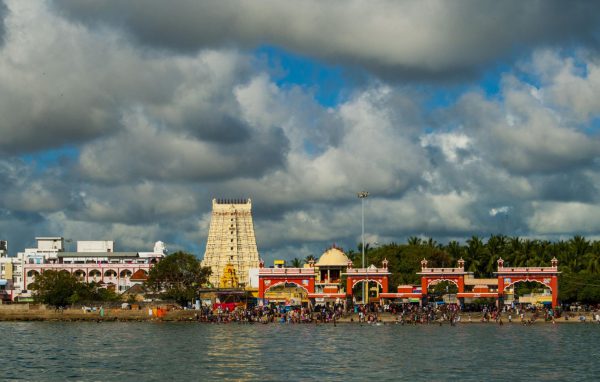

 people viewed
people viewedRameswaram Temple, situated on the serene island of Rameshwaram in Tamil Nadu, stands as a testament to the devout reverence towards Shiva temple in Rameshwaram. Legend has it that Lord Rama installed the Shiva temple in Rameshwaram, adding to its spiritual significance. This sacred site holds immense importance for Hindus worldwide, not only for its spiritual aura but also for its architectural grandeur.
| Darshan Timing | 5:00 a.m. – 1:00 p.m, 3:00 p.m. – 9:00 p.m. |
| Dress Code | Male: Dhoti with Shirt/Pants Female: Saree or Churidhar |
Rameswaram Temple, situated on the serene island of Rameswaram in Tamil Nadu, holds a storied past deeply rooted in Hindu mythology. According to ancient legend, the temple’s origins can be traced back to the time of the epic Ramayana. It is said that Lord Rama, the seventh avatar of Lord Vishnu, along with his consort Sita and devoted ally Hanuman, was returning from Lanka after defeating the demon king Ravan and rescuing Sita.
As they reached the shores of Rameswaram, Lord Rama desired to perform a penance (tapasya) to absolve himself of any perceived sins incurred during the battle with Ravana. To seek forgiveness and blessings, Lord Rama wished to worship Lord Shiva, the supreme deity of Shaivism. However, there was no lingam (a symbolic representation of Lord Shiva) available at the time for the worship.
To address this predicament, Lord Rama instructed Hanuman to fetch a lingam from the Himalayas before dawn. However, due to the urgency of the task and the distance involved, Hanuman was unable to return in time with the lingam. Meanwhile, Sita created a small lingam from the sand of the seashore, known as the Ramalingam.
Upon Hanuman’s return, realizing that he couldn’t find the lingam he was sent to retrieve, he was disheartened. However, Lord Rama reassured Hanuman, affirming that the lingam created by Sita was equally sacred and would serve as the primary deity of worship. Thus, the Ramanathaswamy Temple was established, with the Ramalingam enshrined as the presiding deity.
Throughout the centuries, the temple complex underwent several renovations and expansions under different dynasties and rulers, including the Cholas, Pandyas, and Vijayanagara kings. Each ruler contributed to the architectural splendor and cultural significance of the temple, enhancing its sanctity and allure.
Today, Rameswaram Temple stands as a revered pilgrimage site, attracting millions of devotees annually from across the globe. Pilgrims flock to the temple to seek blessings, perform sacred rituals, and immerse themselves in the rich spiritual heritage of Hinduism. Its history, mythology, and architectural grandeur continue to captivate visitors, making it one of the most cherished and revered temples in India.
The importance of Rameswaram Temple is underscored by its various rituals and pujas, offering devotees a chance to connect deeply with the divine. Among these, the Pooja in Rameswaram Temple holds a special place. The temple offers a range of pujas including:
At the heart of Rameswaram Temple lies the Rameswaram Temple Jyotirlinga, symbolizing the infinite cosmic energy and power of Lord Shiva. Devotees partake in these sacred rituals to seek blessings, spiritual solace, and fulfillment of their desires.
For those planning a Rameswaram Temple visit, reaching this sacred destination is relatively convenient. You can opt to reach by air, train, or road. For those traveling by road, the best taxi service in Rameswaram is offered by Avis luxury car rental service.
| Trip | Distance (Approx.) | Duration |
| Chennai to Rameshwaram | 570 km | 10-12 hours |
| Bangalore to Rameswaram | 570 km | 10-12 hours |
Here’s a list some of the finest accommodations Rameshwaram has to offer:
You can make the most of your Rameswaram trip by exploring nearby attractions which enhances the pilgrimage experience. Simply book Avis taxi service and explore
No visit to Rameshwaram is complete without savoring its local delicacies. From piping hot idlis served with tangy chutneys to mouth-watering seafood dishes, the cuisine of Rameshwaram is sure to tantalize your taste buds. Don’t miss trying out the authentic South Indian thali at local eateries, offering a delectable spread of flavorsome dishes.
In conclusion, a visit to Rameswaram’s Ramanathaswamy Temple is not just a pilgrimage but a journey of spiritual awakening and cultural immersion. The temple, with its rich history and architectural splendor, stands as a symbol of devotion to Lord Shiva and beckons devotees from far and wide to experience its sanctity. Through the various pujas and rituals offered at the temple, devotees seek blessings, solace, and fulfillment of their deepest desires.